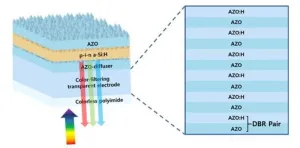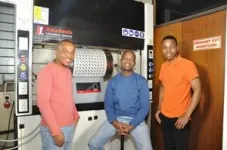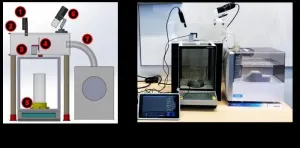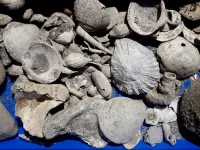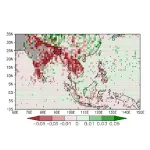(Press-News.org) A research team led by Dr. Jung-dae Kwon from the Department of Energy & Electronic Materials at the Korea Institute of Materials Science(KIMS) has succeeded in realizing the world's first transparent thin-film solar cell on a flexible substrate that exhibits different reflective colours and does not significantly reduce solar cell's efficiency. KIMS is a government-funded research institute under the Ministry of Science and ICT.
This is a technology that achieves reflective colour only a single material by periodically incorporating hydrogen into zinc oxide material doped with aluminium, which is a transparent electrode, to induce a refractive index difference. By designing a multi-layer thin film with an extremely low refractive index difference of less than 5%, the reflection loss in the visible light region absorbed by the solar cell device was minimized. It can be applied to various absorbers for thin-film solar cells as it hardly reduces the solar cell efficiency due to colour implementation. In addition, it is expected to serve as a benchmark for improving the aesthetics of flexible substrate transparent thin-film solar cells for BIPV(Building Integrated Photo Voltaic) and VIPV(Vehicle Integrated Photo Voltaic).
To date, multilayer thinning technology for materials with large refractive index differences, colour control thin film coating technology for designing optical properties, and natural structure mimicking structural colour technology have been used as colour application methods to improve the aesthetics of transparent thin film solar cells. However, these technologies are not suitable for solar cells that absorb visible light due to a wide reflection band and high reflectivity or require complex technologies that are difficult to apply industrially in terms of two or more materials and processes.
The research team formed multilayer thin films with different refractive indices through periodic hydrogen reactions while depositing zinc oxide thin films using the vacuum sputtering deposition method used in general semiconductor and solar cell manufacturing processes. They then obtained the three primary colours of light by adjusting the thickness of the multilayer thin film. At that time, the colour of the electrode was well implemented even when applied to a solar cell that absorbs light in the visible light range.
Multilayer transparent thin film electrode based on a single material does not require additional processing. It is expected that various colours and high efficiency of thin film solar cells can be realized at a low cost. In addition, since the reflective colour is implemented as an optical filter, it can be applied to various fields such as image sensors, photolithography masks, and infrared shielding.
Dr. Jung-dae Kwon, a principal researcher, said,“When commercialized, this technology will help to develop simple and process-free light filter technology and high-efficiency coloured flexible substrate transparent thin-film solar cells, as well as to realize BIPV systems for modern buildings and VIPV systems for vehicles with aesthetic features.”
This research was carried out under the basic research project of the Korea Institute of Materials Science and the energy technology development project of the Korea Institute of Energy Technology Evaluation and Planning with support from the Ministry of Science and ICT. In addition, the research results were published on 3 August in the Chemical Engineering Journal (IF: 15.1), a top-tier journal (in the top 3%) in the field of chemical engineering (First Author: Dr. Choi Soo-won, Corresponding author: Pusan National University, Professor Punggeun Song, Korea Aerospace University, Professor Myung Hoon Shin). Based on this research, the research team is actively conducting follow-up research in the field of solar modules that express colours considering both the aesthetic and practical aspects of BIPV.
-------------------------------------------------------------------------
###
About Korea Institute of Materials Science(KIMS)
KIMS is a non-profit government-funded research institute under the Ministry of Science and ICT of the Republic of Korea. As the only institute specializing in comprehensive materials technologies in Korea, KIMS has contributed to Korean industry by carrying out a wide range of activities related to materials science including R&D, inspection, testing&evaluation, and technology support.
END
Low cost, high efficiency, multiple colors at the same time!
Development of transparent thin-film with flexible substrate and different colors
2023-08-28
ELSE PRESS RELEASES FROM THIS DATE:
New guidance on take-home naloxone for community overdose responders
2023-08-28
New guidance aimed at helping standardize community overdose response and take-home naloxone kits across Canada is published in CMAJ (Canadian Medical Association Journal) https://www.cmaj.ca/lookup/doi/10.1503/cmaj.230128. The guidance is an important document to optimize the effectiveness of take-home naloxone to save lives.
The guidance was developed by a panel of experts, including people with lived experience of drug use and overdose response, front-line and harm-reduction workers, public health professionals, clinicians and academics with expertise in harm reduction across Canada. ...
Indigenous females face disparities in health care in Canada
2023-08-28
Indigenous females living "off reserve" face many disparities in health care access, use and unmet needs, found new research in CMAJ (Canadian Medical Association Journal) https://www.cmaj.ca/lookup/doi/10.1503/cmaj.221407.
The study included 2902 First Nations, 2345 Métis, 742 Inuit and 74 760 non-Indigenous females of reproductive age (aged 15–55 years) obtained from the Canadian Community Health Survey from 2015 to 2020, including 4 months during the COVID-19 pandemic.
"We found that ...
Researcher finds inspiration from spider webs and beetles to harvest fresh water from thin air
2023-08-28
A team of researchers is designing novel systems to capture water vapour in the air and turn it into liquid.
University of Waterloo professor Michael Tam and his PhD students Yi Wang and Weinan Zhao have developed sponges or membranes with a large surface area that continually capture moisture from their surrounding environment.
Traditionally, fresh water for consumption is collected from rivers, lakes, groundwater, and oceans (with treatment). The current technologies Dr. Tam is developing are inspired by nature to harvest water from alternative sources as the world is facing ...
UEA researchers develop new tool to reduce stroke risk
2023-08-28
Peer reviewed – observational study - humans
Researchers at the University of East Anglia have developed a new way of identifying patients at risk of an irregular heartbeat, known as ‘atrial fibrillation’.
While not life threatening, the condition increases people’s risk of having a transient ischaemic attack (TIA) or stroke by up to five times.
A new study, published today, reveals four specific factors that can predict which patients will have atrial fibrillation.
These include older age, higher diastolic blood pressure and problems with both the coordination ...
No evidence grammar school systems are best for the brightest, study of 500,000 pupils reveals
2023-08-28
The UK’s brightest pupils’ chances of getting top GCSE grades are actually lower in grammar schools than in comprehensives, according to a major new piece of research.
The study, which was based on test results and other information from all pupils in England, challenges the common belief that high achievers do better in more academic schools.
Findings, published in the peer-reviewed journal Educational Review, demonstrate those with the highest scores at age 11 were less likely to achieve ...
Auckland wastewater pipe dig reveals 'fossil treasure trove'
2023-08-27
A new New Zealand Journal of Geology and Geophysics paper out today describes the 266 fossil species as one of the richest and most diverse groups of three-million-year-old fauna ever found in New Zealand. At least ten previously unknown species will be described and named in future research.
Fossil treasure trove from Auckland’s Mangere Wastewater Treatment Plant
In 2020, when Auckland’s Watercare were excavating two huge vertical shafts for a major upgrade of the major pipeline that brings raw sewage for treatment from the central city they dug through an ancient shell bed. Auckland paleontologist Bruce Hayward likened ...
Study: Individuals feel sex-specific symptoms before impending cardiac arrest
2023-08-27
Investigators from the Smidt Heart Institute at Cedars-Sinai are one step closer to helping individuals catch a sudden cardiac arrest before it happens, thanks to a study published today in the peer-reviewed journal Lancet Digital Health.
The study, led by sudden cardiac arrest expert Sumeet Chugh, MD, found that 50% of individuals who experienced a sudden cardiac arrest also experienced a telling symptom 24 hours before their loss of heart function.
Smidt Heart Institute investigators also learned that this warning symptom was different for women than it was for men. For women, the most prominent symptom of an impending sudden cardiac ...
Scientists zoom in on the Asian monsoon season using satellite data
2023-08-26
Tokyo, Japan – Scientists from Tokyo Metropolitan University and other institutes have studied new satellite data showing the diameter of rain droplets and the distribution of heavy ice in the atmosphere worldwide. They focused on the Asian monsoon region, finding larger droplets and more heavy ice precipitation on land before the actual monsoon season. Their findings shed new light on the features of the pre-monsoon season, such as more intense precipitation and lightning, potentially informing better weather prediction.
As adverse rainfall events rock the world, scientists are trying to understand the mechanism ...
Observation of metal healing itself confirms Texas A&M researcher’s prediction
2023-08-26
A microscopic crack grew in a very small piece of platinum when placed under repetitive stretching. The experiment, designed to study fatigue crack growth, continued as predicted for a while before something unexpected happened. The crack stopped growing and instead began to get shorter, effectively “healing” itself.
A group of researchers at Sandia National Laboratories made this surprising observation while conducting fracture experiments on nanocrystalline metals. The findings were recently published in the journal Nature.
It ...
NIH selects undergraduate winners of 2023 DEBUT Challenge for impressive medical device designs
2023-08-25
The National Institutes of Health and the higher education non-profit VentureWell have selected 10 winners and five honorable mentions of the Design by Biomedical Undergraduate Teams (DEBUT) Challenge, who are set to receive prizes totaling $145,000. The awards will be presented to the winning teams during the annual Biomedical Engineering Society conference held Oct. 11-14, 2023.
Now in its 12th year, the DEBUT Challenge calls on teams of undergraduate students to produce technological ...
LAST 30 PRESS RELEASES:
Anxiety and insomnia may lower natural killer cell count, potentially repressing immune function
How parasitic, asexual plants evolve and live
Research spotlight: A subset of patients with depression could benefit from anti-inflammatory treatment
New fully digital design paves the way for scalable probabilistic computing
Membrane electrode assembly design for high-efficiency anion exchange membrane water electrolysis
U.S. debt ceiling disputes show measurable impact on global crude oil markets
Climate extremes triggered rare coral disease and mass mortality on the Great Barrier Reef
Direct observation reveals “two-in-one” roles of plasma turbulence
Humans rank between meerkats and beavers in monogamy ‘league table’
US fossil reveals early mass-burial event and ancient microbial attack
Sedative choice could improve outcomes for breathing tube patients
New superconducting thin film for quantum computer chips
Simulations reveal protein "dynamin" constricts cell membranes by loosening its grip
Nearly 1 in 5 UK emergency department patients cared for in corridors/waiting rooms
Heavy energy drink intake may pose serious stroke risk, doctors warn
Violence against women and children among top health threats: New global study reveals disease burden far larger than previously estimated
Predicting who is at risk of developing type 1 diabetes, as new drugs now available
New gene-mapping method unlocks hidden drivers of cancer
Ocean current and seabed shape influence warm water circulation under ice shelves
Call to increase funding for ‘invisible’ Deaf victim-survivors of domestic abuse
University of Maryland School of Medicine names distinguished scientist and academic leader Gerald M. Wilson, PhD, as Chair of the Department of Biochemistry and Molecular Biology
Receptors in mammary glands make livestock and humans inviting hosts for avian flu
Icy hot plasmas
Treating adults with autism: Maryland Clinical Center offers national blueprint for care after pediatric transition
University of Phoenix College of Doctoral Studies releases white paper on reclaiming control to build workforce resilience
NCCN Summit seeks to improve care for veterans and first responders with cancer from line-of-duty exposure
ERC Consolidator Grant for soft robotics researcher
Dual-action arts and wellbeing program transforms dementia care
The global plastic waste trade contributes to coastal litter in importing countries, study shows
UT Dallas partners with Tech Mahindra on AI innovation
[Press-News.org] Low cost, high efficiency, multiple colors at the same time!Development of transparent thin-film with flexible substrate and different colors
